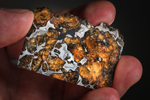Bernard Lammert de Vries
 |
Bernard Lammert de Vries
Astronomy Department, Stockholm University Email: This email address is being protected from spambots. You need JavaScript enabled to view it. Website: http://www.stjerke.com |
||
Scientific papersHere you can find a list of publications about various scientific topics and also my PhD thesis can be downloaded. For the publications for which data and or observations are available, they are also listed. Presentations I have given about selected works can also be viewed. I try to learn more on astronomical objects by studying minerals in the form of small sand-like particles, formed around stars. This research field is often called astro-mineralogy. Much can be learned from minerals, for example, small sand-like particles are the building blocks of rocky (and possibly gaseous) planets. If you want to know more about this method in astronomy, please have a look at the publications below. I also started a laboratory project, where we measure the optical properties of Earth and Solar System minerals (like in meteorites). If you want to know more on this, follow this link One of the main topics I am working on is about planets and planetesimals around young stars. Questions I like to adress are about how generic our Solar System is and if there are possibly planetary systems like our own. I am interested in how large rocky bodies grow in disks around young or evolved stars, what those bodies are made of and which mechanisms act on these bodies (e.g. collisions, weathering or heating). Other topics I like to persue are about the evolution of stars like our Sun or stars that are a few times more heavy. On the one hand I want to know how these stars, and thus our Sun, evolve and what happens if they are almost burned out. On the other hand I am interested to see what kind of disks are formed around these stars at the end of their evolution and see if there are any "surprises" hidden in these disks. I have also been active as an astronomer at the Mercator Telescope on La Palma and several of my observations have been used for scientific research projects on asteroseismology. Those projects let to the papers which are also listed on this page. My PhD thesis is shown with its summary and a possibility to download the whole book. This page ends with a list of conference proceedings. |
|||
 |
In yellow are seen olivine crystals in a matrix material of iron and nickel. This piece of material comes from a pallasite meteorite found in Russia. The crystals seen in this meteorite are found throughout the universe and are closely tied to the planet formation processes around young stars. | ||


